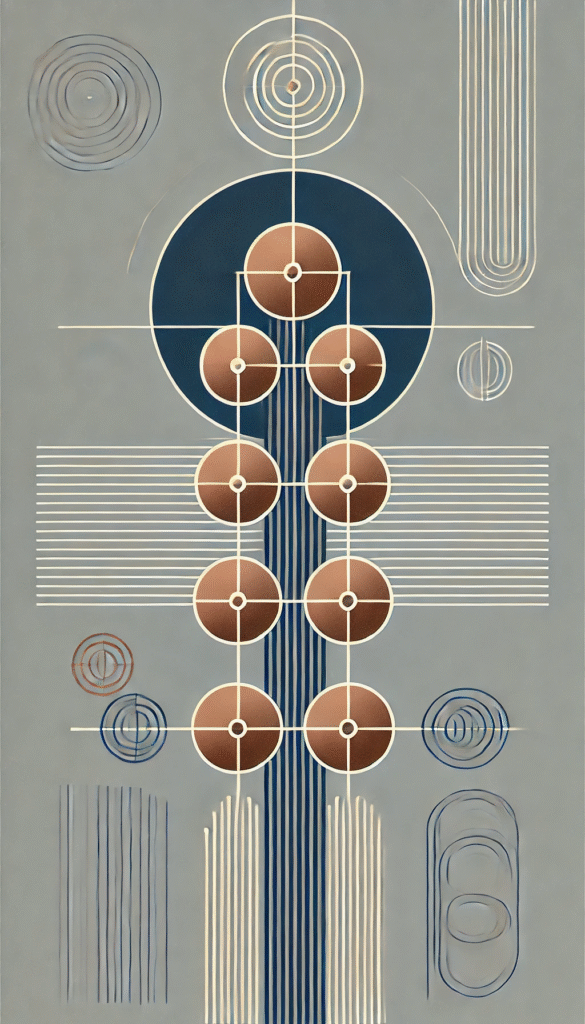
ChatGPT:
The Mathematics of Bell Ringing
Introduction
Bell ringing is both an ancient musical practice and a fascinating mathematical discipline. Professor Sarah Hart’s lecture at Gresham College (2021) explores the history, acoustics, craftsmanship, and especially the mathematics of change ringing. Unlike playing melodies, change ringing involves ringing bells in structured sequences based on permutations. This article explains how bells are made and tuned, how ringing developed in England, and how mathematics—especially group theory—underpins the art.
Bells Across History
Bells are among the loudest and oldest instruments. From ancient China to medieval Europe, they have been used for prayer, celebration, and warnings. European bells took on their familiar flared form over centuries, evolving to maximize resonance and projection. Monumental examples include St Paul’s Cathedral’s Great Paul (16.8 tonnes), Liverpool Cathedral’s “Great George” (14.7 tonnes), and the Olympic Bell (22.9 tonnes).
Making and Tuning Bells
Bronze (a mix of copper and tin) is the traditional bell material—strong enough to withstand repeated strikes, yet resonant. Casting involves loam moulds shaped with straw and hair to allow airflow during cooling. Once cast, bells are tuned by shaving metal from the inside. The 19th-century Simpson Tuning system standardizes five main frequencies: hum, prime, tierce, quint, and nominal. These ensure the bell produces harmonious overtones, even though the “strike note” we hear is a virtual pitch an octave below the nominal.
Full-Circle Ringing in England
While many cultures fixed bells in place, England developed full-circle ringing in the 1500s. Mounting bells on full wheels allowed them to swing completely around, giving ringers precise control. This innovation made it possible to coordinate sequences of bells in strict mathematical patterns. By the 1600s, “ringing the changes” became a popular pastime, blending athletic effort, teamwork, and mathematical challenge.
Change Ringing Rules
In change ringing, bells are numbered from treble (highest) to tenor (lowest). Sequences of notes are called rows. Two rules govern changes:
- Each bell rings once in every row.
- Bells may only swap with adjacent neighbors between rows.
This ensures both variety and physical feasibility. A full set of unique rows is an extent. For example, 6 bells allow 720 rows, while 12 bells yield nearly 480 million rows.
The Rise of Methods
Early ringers experimented with “plain changes” (single swaps). More elaborate methods such as Plain Hunt and Plain Bob introduced systematic swapping patterns. Fabian Stedman’s Campanalogia (1677) formalized these methods. He is credited with inventing many compositions still in use, including Stedman Doubles. His work anticipated group theory, analyzing how sequences avoided repetition to ensure “true” peals.
Mathematics Behind the Music
Change ringing corresponds to the mathematics of permutations. The set of all permutations of n bells forms the group Sₙ. Subgroups, such as the “hunting group,” capture restricted patterns like plain hunting. Cosets (partitions of groups) explain how methods like Plain Bob Minimus cover all rows systematically. Lagrange’s Theorem guarantees that group structures break into equal cosets, making it easier to prove that a method forms a true extent.
Connections extend to geometry: the hunting group on four bells matches the symmetry group of a square, while six-bell hunting aligns with a hexagon’s symmetries. Thus, bell ringing provides a practical example of abstract algebra.
Challenges and Unsolved Problems
Not all extents are easy to achieve. For example, constructing a 7-bell extent with Stedman Triples resisted solution for centuries, only resolved in 1994. Even today, mathematicians and ringers explore open questions about possible peals and their structures.
Bell Ringing in Modern Times
Ringing societies emerged in the 17th century and remain active. Records of peals are meticulously kept, with national databases like PealBase. Computers now assist in checking whether a peal is “true” and exploring possible methods, but they cannot judge musical quality or playability. Bell ringing still requires teamwork, endurance, and artistry.
Conclusion
Bell ringing is more than sound—it is history, craftsmanship, and mathematics in harmony. Its evolution reflects advances in metallurgy, acoustics, and abstract algebra. Whether ringing a small handbell peal or orchestrating a 12-bell tower performance, ringers engage in a living tradition that unites culture and mathematics. The study of bells remains a rich field where art and science continue to resonate together.
FAQs –
The Mathematics of Bell Ringing
What is change ringing?
Change ringing is the practice of ringing a set of tuned church bells in mathematical sequences (called “changes”) rather than playing melodies. Each bell rings once per sequence, and ringers follow strict rules to move from one row to the next.
How many possible ringing sequences are there for a set of bells?
The number of possible rows is given by factorials (n!). For example:
- 3 bells → 6 rows
- 6 bells → 720 rows
- 8 bells → 40,320 rows
- 12 bells → nearly 480 million rows
- 19 bells → about 7.7 billion years to ring them all at 2 seconds per row.
Why are bells shaped the way they are?
The flared shape of bells enhances resonance, produces multiple harmonics, and efficiently transfers sound waves into the air. It allows bells to act almost like a chord on their own, giving richness and projection to the sound.
What materials are church bells made from?
Most bells are cast from bronze (copper + tin), which balances strength and resonance. Bronze withstands repeated strikes from the clapper while producing a bright, ringing tone.
How are bells tuned?
Once cast, bells can only be tuned by removing metal from the inside to lower the pitch. Modern foundries use lathes to adjust five main frequencies (nominal, quint, tierce, prime, hum), following “Simpson Tuning.”
What is a “true” peal?
A true peal is a ringing performance in which no row is repeated (except the final return to rounds). Traditionally, a peal also requires more than 5,000 changes, taking about 3 hours to ring.
Who was Fabian Stedman?
Fabian Stedman (1640–1713) was a London printer and ringer who published the first systematic books on change ringing (Tintinnalogia, 1668, and Campanalogia, 1677). He introduced structured methods like Stedman Doubles and anticipated group-theoretic reasoning.
How does mathematics connect to bell ringing?
Change ringing is based on permutations—different orders of bells. The rules correspond to adjacent swaps, which form subgroups of the full permutation group (Sₙ). Group theory helps explain methods, extents, and why some sequences are possible while others are not.
What is the largest working bell in the world?
The Bell of Good Luck in Henan, China, weighs 116 tonnes and can be rung. By contrast, Russia’s Tsar Bell (202 tonnes) is heavier but cracked before it was ever rung.
What role do computers play in bell ringing today?
Computers help verify whether compositions are “true” and explore possible extents. However, they cannot judge musicality, rhythm, or ease of ringing—so human creativity and teamwork remain essential.
Here are the 10 most relevant quotes from The Mathematics of Bell Ringing by Sarah Hart (2021):
- “The number of possible permutations of n things, in this case the number of possible rows of our n bells, is n factorial.”
- “It has been estimated that the Sun will engulf the Earth in about 7.5 billion years… if we start right now and play really fast, we might just be able to do an extent of 19 bells.”
- “A bell is in essence producing a musical chord all on its own.”
- “During the swing, a bell generates forces of up to four times its weight downwards and twice its weight laterally.”
- “Ringing the changes… became a very popular pastime – even a sport.”
- “A true performance must not contain any repeated rows (except the final row of rounds).”
- “Fabian Stedman… although of course he does not use modern mathematical language, puts considerable effort into explaining how we can be sure that the peals described are true extents.”
- “The set of all permutations on n bells is a group, and in mathematics it is known as Sₙ.”
- “Interestingly, these hunting groups crop up in a quite different context – symmetry groups… the hunting group on six bells is the same, mathematically speaking, as the symmetry group of the regular hexagon.”
- “Computers can certainly test candidate peals or extents to see if they are true, but they are less good at judging their musical quality or other desirable factors.”

